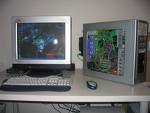What is Hardware?
Are these terms familiar to you? Monitor, RAM, CD drive, CPU, graphic cards are all hardware, or more accurately, computer hardware. These components make up a computer, working together with computer software to make a computer work.
Simply put, hardware is the tangible parts of your computer, parts you can touch, feel and so on।
Hardware Failures
As mentioned before, hardware and software work together to form a fully functional system, theoretically. However, rarely do you get a fully functional system all the time. There will almost certainly be malfunction of hardware, be it within the electronic circuits or even the whole component itself. Sometimes, the originating factor of the hardware failure is not the components of the system itself, but due to outside factors such as environmental disasters like fire, earthquakes and lightning storm.
Recovery of failed hardware components is not a big problem by itself. It is basically identifying and replacing the problematic component. However, hardware failures are most deadly, when it affects daily routine and affecting critical personal or business data. This is especially true of the most important component of a computer system when it comes to storage of data, the hard disk.
The following is a list of common hardware failures:
RAM Failures
Power Connector
Hard Disk
Overheating
LCD Failures
Motherboard
USB Box
RAM Failures
Bad RAM is somehow harder to diagnose as similar symptoms may be caused by software problems, other hardware problems or even motherboard failure. However if you experience any of these symptoms, users should check for bad RAM before attempting any other troubleshooting.
Symptoms:
Windows doesn't start showing different error messages each time.
Windows crashes (blue screen) or freezes frequently.
Windows crashes as soon as you try to start a program.
Unexplained random crashes and freezes without error messages.
Power Adaptor
The common weak spot on any laptop is the DC power jack. If someone trips over the power adapter cable while it is still connected to the laptop, there is a high possibility that the power jack will get severely damaged.
On most laptops, the DC power jack is soldered directly to the motherboard and there are only three or four small pins holding it in place, which makes the power jack rather weak. Any sideways pulling of the DC power cord while attached to the laptop will usually dislodge at least one of these pins, breaking the solder around it. Modern laptops use quite a lot of power, from about 70W to 120W or even more. The bad electrical connection from the dislodged pin will cause sparks and heating that will eventually burn a hole through the motherboard and can even be a fire hazard.
Symptoms which indicates poor contact between the DC power jack and the motherboard:
The battery is not charging properly or stays at half charge despite having to use the power adaptor.
The screen flickers (the brightness is changing) while the power cord is plugged in. This is caused by the laptop switching between DC power (screen is brighter) and battery power (screen is dimmer).
The DC plug gets hot after a few minutes of use and may even smell of burning.
There are "scratching" sounds coming from the DC jack.
How to test for broken power jack:
1. Remove the battery
2. Plug in the power cord
3. Start the laptop
4. Gently wiggle the DC power plug on the back of the laptop
If the laptop shuts down abruptly (looses power), find the dealer to re-solder or change the DC power jack as soon as possible as the motherboard has already started to burn around the dislodged pins. The manufacturer might offer to replace the whole motherboard; however the price of a new motherboard together with the labor charge for installing it will usually cost more than the current value of that laptop and sometimes can the pricing can cost over a thousand dollars.
Replacing or re-soldering the DC power jack is not an easy job. It usually takes a few hours depending on the damage and the model of the laptop. To reach the power jack, the laptop has to be completely disassembled and have the motherboard taken out. Then if the board around the dislodged pin is badly burned, the power jack has to be un-soldered and the board has to be patched.
After that a different power jack has to be installed, attached to the case of the laptop and connected with wires to the motherboard, as the patched board wouldn't be strong enough to support the original type of power jack that was soldered directly to the board.
Sunday, January 6, 2008
Diagnosing Troubleshooting Computer
Labels: Computer Hardware
Posted by Brijesh at 10:12 PM 0 comments
Subscribe to:
Comments (Atom)
